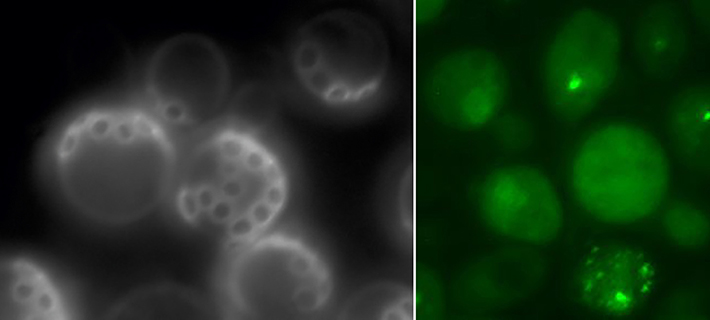
The age of the yeast can be determined by counting the bud scars (left). As the cells age, you can examine how proteins
One benefit of antioxidants, such as vitamins C and E, is that they neutralise reactive oxygen species – known as oxidants – which may otherwise react with important molecules in the body and destroy their biological functions. Larger amounts of oxidants can cause serious damage to DNA, cell membranes and proteins for example. Our cells have therefore developed powerful defence mechanisms to get rid of these oxidants, which are formed in our normal metabolism.
It was previously believed that oxidants were only harmful, but recently we have begun to understand that they also have positive functions. Now, the new research from Chalmers University of Technology shows that the well-known oxidant hydrogen peroxide can actually slow down the ageing of yeast cells. Hydrogen peroxide is a chemical used for hair and tooth whitening, among other things. It is also one of the oxidants formed in our metabolism that is harmful at higher concentrations.
Less food gives longer life
The Chalmers researchers studied the enzyme Tsa1, which is part of a group of antioxidants called peroxiredoxins.“Previous studies of these enzymes have shown that they participate in yeast cells' defences against harmful oxidants,” says Mikael Molin, who leads the research group at Chalmers’ Department of Biology and Biological Engineering. “But the peroxiredoxins also help extend the life span of cells when they are subjected to calorie restriction. The mechanisms behind these functions have not yet been fully understood.”
It is already known that reduced calorie intake can significantly extend the life span of a variety of organisms, from yeast to monkeys. Several research groups, including Mikael Molin’s, have also shown that stimulation of peroxiredoxin activity in particular is what slows down the ageing of cells, in organisms such as yeast, flies and worms, when they receive fewer calories than normal through their food.
“Now we have found a new function of Tsa1,” says Cecilia Picazo, postdoctoral researcher at the Division of Systems and Synthetic Biology. “Previously, we thought that this enzyme simply neutralises reactive oxygen species. But now we have shown that Tsa1 actually requires a certain amount of hydrogen peroxide to be triggered to participate in the process of slowing down the ageing of yeast cells.”
Surprisingly, the study shows that Tsa1 does not affect the levels of hydrogen peroxide in aged yeast cells. On the contrary, Tsa1 uses small amounts of hydrogen peroxide to reduce the activity of a central signalling pathway when cells are getting fewer calories. The effects of this ultimately lead to a slowdown in cell division and processes linked to the formation of the cells’ building blocks. The cells' defences against stress are also stimulated – which causes them to age more slowly.
Could lead to drugs that mimic the positive effects of calorie restriction
“Signal pathways which are affected by calorie intake may play a central role in ageing by sensing the status of many cellular processes and controlling them,” says Mikael Molin. “By studying this, we hope to understand the molecular causes behind why the occurrence of many common diseases such as cancer, Alzheimer's disease, and diabetes shows a sharp increase with age.”The fact that researchers have now come a step closer to understanding the mechanisms behind how oxidants can actually slow down ageing could lead to new studies, for example looking for peroxiredoxin-stimulating drugs, or testing whether age-related diseases can be slowed by other drugs that enhance the positive effects of oxidants in the body.
Text: Johanna Wilde, Susanne Nilsson Lindh and Joshua Worth
chalmers.se/en


